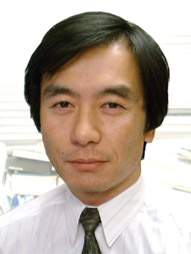Coherently additive THz diamond emitters and their applications
Associated Professor Hitoki YONEDA
yoneda@ils.uec.ac.jp
http://www.ils.uec.ac.jp/~yoneda

The aim of this research is to develop a high power Terahertz (THz) radiation source using a diamond photoconductive device. The objectives is to open a new field of nonlinear optics in THz frequency range. THz radiation covers the frequency range between 100 GHz and 10 THz (i.e. a wavelength between 3 mm and 30 ƒÊm), which spans the spectral interval between the microwave- and the infrared regions of the electromagnetic spectrum.

Fig.1
To date, a 2-kV DC voltage can be applied to the 10-ƒÊm PCD gap with an over-coated layer for keeping sufficiently high dark-current resistivity. This electric field strength is two orders of magnitude larger than that of conventional GaAs emitters. We produced high energy density (10ƒÊJ/cm2) THz emission by inducing coherently-additive emission from more than 2000 photoconductive emitters using an ultra-short pulse Kr*F laser (Fig.2).
